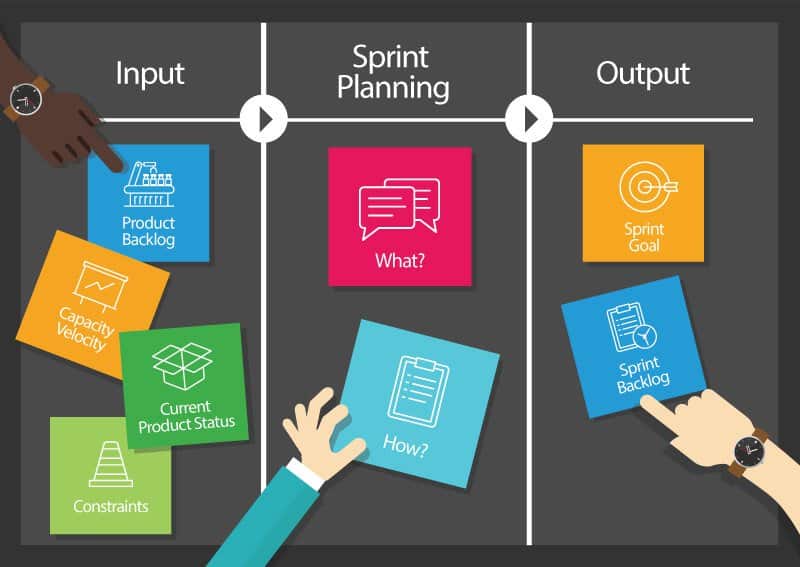Execute Your Sprint For Maximum Output
Sprint planning is central to the success of Scrum projects. In Agile development effective planning of sprints distinguishes from others such as waterfall, prototyping, and so on. Sprint completion should ideally result in the creation of deliverables at regular intervals that can then be provided to clients for regular feedback. This is especially useful if a project's requirements are constantly evolving and changing over time, and it is one of the many significant benefits of the Scrum framework.
Set the sprint goal
Setting a sprint goal is an essential part of any sprint planning. It should be specific, measurable, and the result of a discussion between the product owner and the development team.
To help you set the sprint goal, ask yourself the following questions:
What do we want to achieve? This is not just about the isolated sprint, but also about its contribution to the product as a whole.
How can we achieve this goal? The team needs to go through each point and make sure everyone understands its requirements and can anticipate potential obstacles. This helps both estimate and clarify the sprint goal.
How can we verify that we have achieved this goal? In other words, the definition of "done" that is unique to your team, and it's your job to make sure you are all on the same page.
Another important aspect to consider is whether the goal you want to set is challenging enough. You do not want to set a goal that is too easy to achieve just to have a successful sprint. After all, Scrum is about continuous improvement from iteration to iteration, and if you set the bar too low, it will not contribute to the product or the team. Make the goal challenging enough to get the best out of your team.
Once you set the sprint goal, it will serve as a guide for the development team and help them prioritize how to achieve it.
Who participates in sprint planning?
The scrum team, the product owner, and the scrum master are the three key players in sprint planning.
The person in charge of turning their vision for the product into a finished one is known as the Product Owner, and they are the ones who own the finished item that is produced at the conclusion of a sprint.
The Scrum Master is a team member who facilitates Sprint meetings and the development process primarily. He or she makes sure that ethical agile methods are applied during the product's development. The absence of a qualified Scrum Master is not a deal breaker for most interviewees, despite the fact that some are.
Last but not least, the scrum team decides on the list of backlog items, or required product functionality, that may be finished and satisfied by the conclusion of the sprint. This prevents missed deadlines and is crucial for establishing the best sprint objective.
Leave room for flexibility
Any agile methodology is inherently flexible, and Scrum is no exception. If there is no room for flexibility, something has gone seriously wrong.
It's important to acknowledge that not everything will always go according to plan. You will always encounter new information, stakeholder insights, and dependencies that the team must adjust to. Make sure the team understands that they need to be flexible and that they will be supported throughout each sprint.
How do you plan it effectively?
1. Why is a sprint planning meeting necessary?
Sprint planning meetings set the tone for all work on a particular sprint. These meetings contextualize the work of past sprints in relation to future sprints to ensure timely delivery of all end products. They also make it clear to all stakeholders what the expectations are for the final product and what processes will be used to achieve those expectations.
2. Involve the team
Dysfunctional sprint meetings are usually due to dissatisfied teams that feel left out of the planning process. This is where the Scrum Master needs to step in and use their influence to include all team members and consider them and their skills in a mutually beneficial way.
3. Use inputs from previous sprints
If this is not the first sprint in the development process, feedback from previous sprints can help the team repeat and avoid past mistakes to ensure seamless and smoother development. Past sprint reviews and sprint retrospectives are immensely useful here.
4. Ensure the availability of your team
This point is especially important as the vacation season approaches and team members are unavailable for large portions of the sprint.
5. Update your user stories
Maintaining your user stories along with the backlog is a great way to see your project from the perspective of the potential end user and the difficulties they might have using your product.
6. Use estimates to make decisions based on team capacity
Overloading your team or an individual beyond their capacity does far more harm than good. The team will be more likely to make mistakes and morale will drop if goals remain perpetually unattainable. Use agile estimation techniques and story points to better understand workload and capacity. How much work and effort is required to achieve your goals? Make sure you set realistic and reasonable goals based on your best estimates.
7. Prioritize the tasks
Now that you have taken the time to set the sprint goal and clarify all the tasks, it's much easier to prioritize the tasks that will help you achieve that goal.
There is no right or wrong way to decide on priorities, as long as your team members engage in an active discussion and decide together what should get done during the sprint. This can be done by simply having team members discuss what they want to accomplish by completing this task and what successful completion might bring them.
Some teams prefer to tackle the larger tasks first and save the smaller ones for the end, while others prefer to complete the smaller tasks first so they have more time to focus on the complex tasks. Your workflow can be unique in its own way, as long as the tasks are consistent with your goal and everyone is in sync.
8. Keep your workload reasonable.
Taking on too many chores and being overconfident are both simple to do. Taking on too many duties will be detrimental, even though the Sprint objective should be challenging for the team to complete. Frustration and disappointment are sparked when the team fails to provide what was agreed upon.
By calculating the time needed to complete each activity, this problem may be resolved. Using your prior expertise doing jobs of a comparable nature is both possible and recommended:
Which original estimation did you have?
Did you complete the delivery by then?
Explicit obstacles halted the process?
The likelihood of running across them again is what?
Can you foresee any other obstacles?




